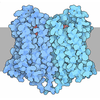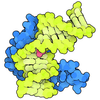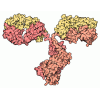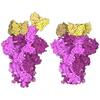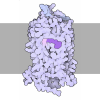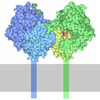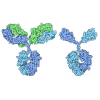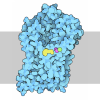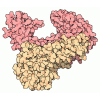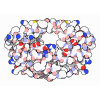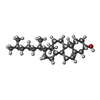+ Open data
Open data
- Basic information
Basic information
| Entry | Database: PDB / ID: 8zpl | |||||||||||||||||||||||||||
|---|---|---|---|---|---|---|---|---|---|---|---|---|---|---|---|---|---|---|---|---|---|---|---|---|---|---|---|---|
| Title | Cryo-EM strucutre of CXCR4 complexed with antagonist HF51116 | |||||||||||||||||||||||||||
 Components Components |
| |||||||||||||||||||||||||||
 Keywords Keywords | SIGNALING PROTEIN / CXC motif chemokine receptor 4 / antagonist | |||||||||||||||||||||||||||
| Function / homology |  Function and homology information Function and homology informationC-X-C motif chemokine 12 receptor activity / positive regulation of macrophage migration inhibitory factor signaling pathway / Specification of primordial germ cells / CXCL12-activated CXCR4 signaling pathway / myosin light chain binding / myelin maintenance / C-X-C chemokine receptor activity / positive regulation of vasculature development / Signaling by ROBO receptors / regulation of chemotaxis ...C-X-C motif chemokine 12 receptor activity / positive regulation of macrophage migration inhibitory factor signaling pathway / Specification of primordial germ cells / CXCL12-activated CXCR4 signaling pathway / myosin light chain binding / myelin maintenance / C-X-C chemokine receptor activity / positive regulation of vasculature development / Signaling by ROBO receptors / regulation of chemotaxis / Formation of definitive endoderm / C-C chemokine receptor activity / Developmental Lineage of Pancreatic Acinar Cells / C-C chemokine binding / Chemokine receptors bind chemokines / anchoring junction / dendritic cell chemotaxis / cellular response to cytokine stimulus / cell leading edge / positive regulation of oligodendrocyte differentiation / Binding and entry of HIV virion / regulation of cell adhesion / coreceptor activity / neurogenesis / ubiquitin binding / cell chemotaxis / calcium-mediated signaling / electron transport chain / G protein-coupled receptor activity / brain development / response to virus / late endosome / positive regulation of cold-induced thermogenesis / actin binding / positive regulation of cytosolic calcium ion concentration / virus receptor activity / cytoplasmic vesicle / G alpha (i) signalling events / periplasmic space / early endosome / response to hypoxia / electron transfer activity / lysosome / immune response / positive regulation of cell migration / G protein-coupled receptor signaling pathway / iron ion binding / inflammatory response / external side of plasma membrane / apoptotic process / heme binding / ubiquitin protein ligase binding / cell surface / protein-containing complex / extracellular exosome / plasma membrane / cytoplasm Similarity search - Function | |||||||||||||||||||||||||||
| Biological species |    Homo sapiens (human) Homo sapiens (human) | |||||||||||||||||||||||||||
| Method | ELECTRON MICROSCOPY / single particle reconstruction / cryo EM / Resolution: 3.01 Å | |||||||||||||||||||||||||||
 Authors Authors | Jiao, H.Z. / Hu, H.L. | |||||||||||||||||||||||||||
| Funding support |  China, 1items China, 1items
| |||||||||||||||||||||||||||
 Citation Citation |  Journal: Proc Natl Acad Sci U S A / Year: 2025 Journal: Proc Natl Acad Sci U S A / Year: 2025Title: Structural mechanisms underlying the modulation of CXCR4 by diverse small-molecule antagonists. Authors: Xiaohong Sang / Haizhan Jiao / Qian Meng / Xiong Fang / Qi Pan / Jiao Zhou / Tingli Qian / Wanqin Zhang / Yan Xu / Jing An / Ziwei Huang / Hongli Hu /   Abstract: CXCR4 (CXC chemokine receptor type 4), a member of the G protein-coupled receptor superfamily, plays a role in cell migration and functions as a coreceptor for HIV entry. Molecular therapeutics ...CXCR4 (CXC chemokine receptor type 4), a member of the G protein-coupled receptor superfamily, plays a role in cell migration and functions as a coreceptor for HIV entry. Molecular therapeutics targeting CXCR4 have been under intensive investigation. To date, only two small-molecule antagonist drugs targeting CXCR4, plerixafor (AMD3100) and mavorixafor (AMD070), have been approved. Here, we present the high-resolution structures of CXCR4 complexed with AMD3100 and AMD070, as well as a small-molecule antagonist HF51116 that has very different chemical structure and binding mechanism from AMD3100 and AMD070. The interactions between these antagonists and the receptor are analyzed in details, and the mechanisms of antagonism are elucidated. Both the major and minor subpockets on CXCR4 are found to be involved in binding of these small-molecule antagonists. The distinct conformations of Trp94 observed in these structures highlight the plasticity of the binding pocket on CXCR4, offering valuable insights into the exploration and refinement of therapeutic strategies targeting this chemokine receptor. | |||||||||||||||||||||||||||
| History |
|
- Structure visualization
Structure visualization
| Structure viewer | Molecule:  Molmil Molmil Jmol/JSmol Jmol/JSmol |
|---|
- Downloads & links
Downloads & links
- Download
Download
| PDBx/mmCIF format |  8zpl.cif.gz 8zpl.cif.gz | 102.7 KB | Display |  PDBx/mmCIF format PDBx/mmCIF format |
|---|---|---|---|---|
| PDB format |  pdb8zpl.ent.gz pdb8zpl.ent.gz | Display |  PDB format PDB format | |
| PDBx/mmJSON format |  8zpl.json.gz 8zpl.json.gz | Tree view |  PDBx/mmJSON format PDBx/mmJSON format | |
| Others |  Other downloads Other downloads |
-Validation report
| Summary document |  8zpl_validation.pdf.gz 8zpl_validation.pdf.gz | 516.9 KB | Display |  wwPDB validaton report wwPDB validaton report |
|---|---|---|---|---|
| Full document |  8zpl_full_validation.pdf.gz 8zpl_full_validation.pdf.gz | 520.1 KB | Display | |
| Data in XML |  8zpl_validation.xml.gz 8zpl_validation.xml.gz | 9.8 KB | Display | |
| Data in CIF |  8zpl_validation.cif.gz 8zpl_validation.cif.gz | 14.7 KB | Display | |
| Arichive directory |  https://data.pdbj.org/pub/pdb/validation_reports/zp/8zpl https://data.pdbj.org/pub/pdb/validation_reports/zp/8zpl ftp://data.pdbj.org/pub/pdb/validation_reports/zp/8zpl ftp://data.pdbj.org/pub/pdb/validation_reports/zp/8zpl | HTTPS FTP |
-Related structure data
| Related structure data |  60348MC  8zpmC  8zpnC M: map data used to model this data C: citing same article ( |
|---|---|
| Similar structure data | Similarity search - Function & homology  F&H Search F&H Search |
- Links
Links
- Assembly
Assembly
| Deposited unit | 
|
|---|---|
| 1 |
|
- Components
Components
| #1: Antibody | Mass: 18665.906 Da / Num. of mol.: 1 Source method: isolated from a genetically manipulated source Source: (gene. exp.)   | ||||||
|---|---|---|---|---|---|---|---|
| #2: Protein | Mass: 55451.062 Da / Num. of mol.: 1 Source method: isolated from a genetically manipulated source Source: (gene. exp.)   Homo sapiens (human) Homo sapiens (human)Gene: cybC, CXCR4 / Production host:  | ||||||
| #3: Chemical | | #4: Chemical | ChemComp-A1D8K / ( | Mass: 522.729 Da / Num. of mol.: 1 / Source method: obtained synthetically / Formula: C29H46N8O / Feature type: SUBJECT OF INVESTIGATION Has ligand of interest | Y | Has protein modification | Y | |
-Experimental details
-Experiment
| Experiment | Method: ELECTRON MICROSCOPY |
|---|---|
| EM experiment | Aggregation state: PARTICLE / 3D reconstruction method: single particle reconstruction |
- Sample preparation
Sample preparation
| Component | Name: HF51116-CXCR4-KOR-Nb6 / Type: COMPLEX / Entity ID: #1-#2 / Source: MULTIPLE SOURCES |
|---|---|
| Source (natural) | Organism:  Homo sapiens (human) Homo sapiens (human) |
| Source (recombinant) | Organism:  |
| Buffer solution | pH: 7.5 |
| Specimen | Embedding applied: NO / Shadowing applied: NO / Staining applied: NO / Vitrification applied: YES |
| Vitrification | Cryogen name: ETHANE |
- Electron microscopy imaging
Electron microscopy imaging
| Experimental equipment |  Model: Titan Krios / Image courtesy: FEI Company |
|---|---|
| Microscopy | Model: FEI TITAN KRIOS |
| Electron gun | Electron source:  FIELD EMISSION GUN / Accelerating voltage: 300 kV / Illumination mode: FLOOD BEAM FIELD EMISSION GUN / Accelerating voltage: 300 kV / Illumination mode: FLOOD BEAM |
| Electron lens | Mode: BRIGHT FIELD / Nominal defocus max: 2000 nm / Nominal defocus min: 1500 nm |
| Image recording | Electron dose: 51.6 e/Å2 / Film or detector model: GATAN K3 BIOQUANTUM (6k x 4k) |
| EM imaging optics | Energyfilter name: GIF Bioquantum / Energyfilter slit width: 20 eV |
- Processing
Processing
| EM software | Name: PHENIX / Category: model refinement | ||||||||||||||||||||||||
|---|---|---|---|---|---|---|---|---|---|---|---|---|---|---|---|---|---|---|---|---|---|---|---|---|---|
| CTF correction | Type: PHASE FLIPPING AND AMPLITUDE CORRECTION | ||||||||||||||||||||||||
| 3D reconstruction | Resolution: 3.01 Å / Resolution method: FSC 0.143 CUT-OFF / Num. of particles: 142111 / Symmetry type: POINT | ||||||||||||||||||||||||
| Refine LS restraints |
|
 Movie
Movie Controller
Controller





 PDBj
PDBj
